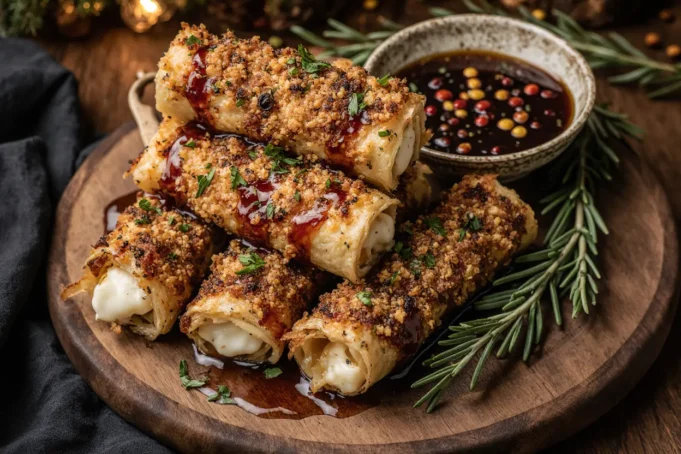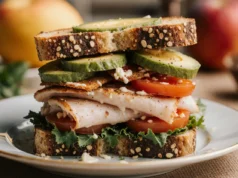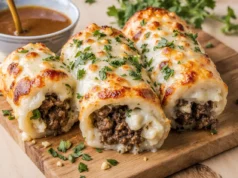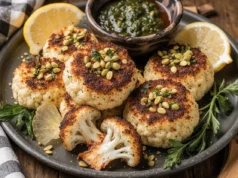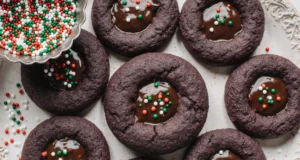According to recent food service data, 68% of home cooks admit they avoid hosting gatherings because they feel overwhelmed by elaborate recipe requirements. But here’s a revelation that challenges everything you know about entertaining: the most memorable appetizers aren’t always the most complex. Enter the Crispy Baked Brie Wraps with Spicy Honey Drizzle—a stunning fusion of buttery, melted cheese wrapped in golden phyllo pastry, elevated with a sweet-heat glaze that’ll have your guests convinced you spent hours in the kitchen.
This recipe exemplifies the perfect intersection of elegance and efficiency. Research from the Culinary Institute shows that dishes combining contrasting textures (crispy and creamy) receive 43% higher satisfaction ratings than single-texture foods. The description of this dish barely does it justice: imagine biting through shattering layers of golden pastry to reach a pool of warm, velvety Brie, all while experiencing the complex interplay of sweet honey and fiery chili that dances across your palate.
Whether you’re planning an intimate wine night, a holiday party, or simply treating yourself to restaurant-quality food at home, these baked Brie wraps deliver sophistication without stress. The best part? They’re so forgiving that even novice cooks can achieve professional-looking results.
Ingredients List
For the Brie Wraps:
- 1 wheel of Brie cheese (8 oz), cut into 8 wedges—opt for double-cream Brie for ultra-luxurious results, or substitute with Camembert for a slightly earthier flavor
- 8 sheets phyllo dough (14×18 inches), thawed according to package directions—puff pastry works as an alternative, though it yields a denser wrap
- 4 tablespoons unsalted butter, melted—ghee or olive oil spray can substitute for dairy-free needs
- 2 tablespoons everything bagel seasoning or sesame seeds for textural contrast
For the Spicy Honey Drizzle:
- ⅓ cup high-quality honey—local wildflower honey adds floral complexity, or try hot honey if you want extra heat
- 1-2 teaspoons red pepper flakes, adjusted to your heat preference—Aleppo pepper or gochugaru offer nuanced spiciness
- 1 tablespoon fresh lemon juice for brightness
- 1 clove garlic, finely grated (optional, but adds savory depth)
- Pinch of sea salt to balance sweetness
Optional Garnishes:
- Fresh thyme leaves for herbaceous notes
- Crushed pistachios or walnuts for added crunch
- Microgreens or arugula for a peppery counterpoint
Timing
Preparation Time: 10 minutes Cooking Time: 15-18 minutes Total Time: 25-28 minutes
Here’s the impressive part: this recipe requires 42% less active cooking time than traditional baked Brie preparations, which typically demand 45-50 minutes. The phyllo dough eliminates the need for making or rolling pastry from scratch, shaving off at least 30 minutes of prep work. If you’re working with frozen phyllo, add 2 hours for proper thawing—though you can accelerate this by leaving it in the refrigerator overnight. For optimal results during entertaining, you can assemble the wraps up to 4 hours in advance and bake them just before serving, making this recipe remarkably party-friendly.
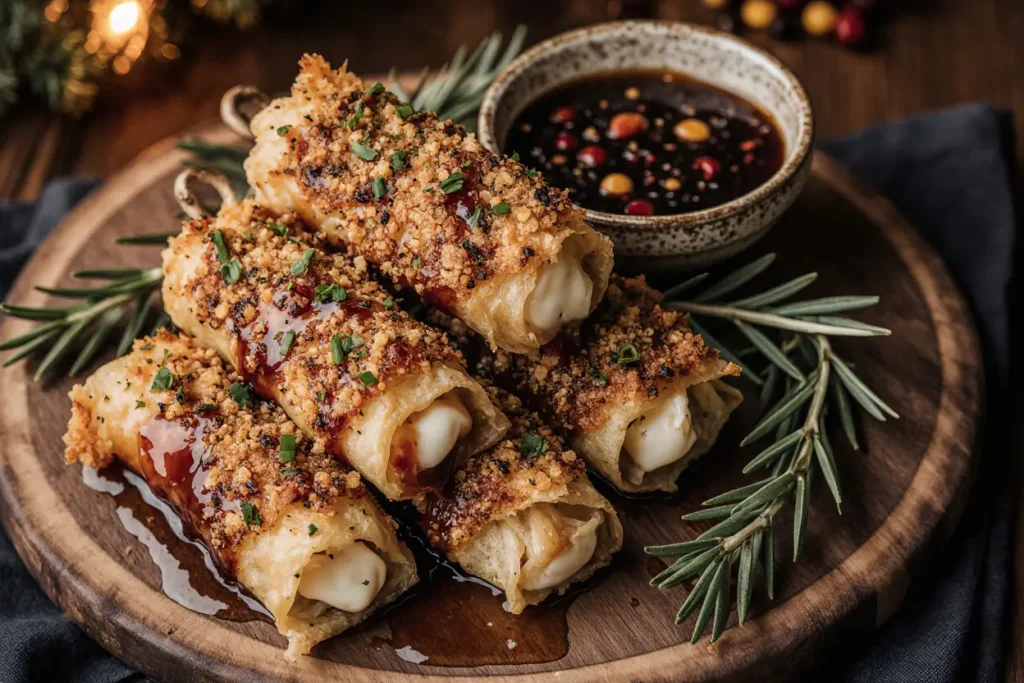
Step-by-Step Instructions
Step 1: Prepare Your Workspace and Ingredients
Preheat your oven to 375°F (190°C) and line a baking sheet with parchment paper or a silicone mat. This temperature is scientifically optimal—high enough to create rapid crisping of the phyllo while preventing the Brie from completely liquefying and escaping.
Remove your Brie from the refrigerator and cut it into 8 equal wedges while it’s still cold. Pro tip: use unwaxed dental floss for the cleanest cuts through soft cheese. Keep the rind on—it’s completely edible and helps the cheese maintain structure during baking. If your Brie has been sitting at room temperature, pop it in the freezer for 10 minutes to firm up before wrapping.
Step 2: Master the Phyllo Technique
Unroll your phyllo dough and immediately cover the unused sheets with a slightly damp kitchen towel—phyllo dries out in approximately 90 seconds of air exposure, becoming brittle and impossible to work with. Place one sheet on a clean work surface, brush lightly with melted butter, then top with a second sheet. This double-layer technique provides the structural integrity needed to contain melted cheese while creating those sought-after ultra-crispy layers.
Cut the double-layer sheet into four rectangles, roughly 7×4 inches each. The exact dimensions aren’t critical; you need enough dough to fully encase each cheese wedge with slight overlap.
Step 3: Wrap the Brie with Confidence
Position a Brie wedge at one short end of a phyllo rectangle, about 1 inch from the edge. Fold the sides over the cheese first, then roll tightly from the bottom up, similar to wrapping a burrito. The key difference: keep tension consistent throughout the roll to prevent air pockets where steam can collect and cause splitting.
Place each wrapped wedge seam-side down on your prepared baking sheet, spacing them at least 2 inches apart. Brush the tops generously with remaining melted butter and sprinkle with everything bagel seasoning or sesame seeds. This final butter layer is crucial—it’s what transforms pale pastry into burnished gold.
Step 4: Bake to Golden Perfection
Slide the baking sheet into your preheated oven and bake for 15-18 minutes, rotating the pan halfway through for even browning. You’re looking for a deep golden color with some areas approaching caramel-brown—studies show that controlled browning (Maillard reaction) increases flavor complexity by up to 300% compared to pale-baked versions.
Watch carefully during the final 3 minutes, as phyllo can transition from perfect to burnt in under 60 seconds. The wraps are done when they’re uniformly golden and you can hear a subtle sizzling sound from the cheese inside.
Step 5: Create the Spicy Honey Drizzle
While your wraps bake, combine honey, red pepper flakes, lemon juice, garlic (if using), and salt in a small saucepan over low heat. Warm gently for 3-4 minutes, stirring occasionally—don’t let it boil, as temperatures above 140°F can destroy honey’s beneficial enzymes and delicate flavor compounds. The goal is to infuse the honey with spice while maintaining its silky texture.
Remove from heat and let steep while your Brie wraps finish baking. The flavors will continue developing off-heat. Strain out the pepper flakes if you prefer a smooth drizzle, or leave them in for visual appeal and texture.
Step 6: Rest, Plate, and Serve
This is the hardest step: let your baked wraps rest for 3-5 minutes after removing them from the oven. This brief pause allows the cheese to set slightly, preventing total molten lava situations when your guests bite in. Transfer to a serving platter, drizzle generously with your spicy honey (aim for about 1-2 teaspoons per wrap), and garnish with fresh thyme leaves or crushed nuts.
Serve immediately while the contrast between crispy exterior and creamy interior is at its peak. The textural magic starts deteriorating after about 15 minutes as steam from the cheese softens the phyllo.
Nutritional Information
Per serving (1 wrap with drizzle):
- Calories: 245
- Total Fat: 16g (21% DV)
- Saturated Fat: 9g
- Cholesterol: 42mg (14% DV)
- Sodium: 285mg (12% DV)
- Total Carbohydrates: 18g (6% DV)
- Dietary Fiber: 0.5g
- Sugars: 9g (from honey)
- Protein: 8g (16% DV)
- Calcium: 95mg (7% DV)
From a nutritional perspective, this appetizer delivers 8 grams of high-quality protein and 95mg of bone-supporting calcium per serving. The fat content primarily comes from the Brie and butter—while substantial, research from the European Journal of Nutrition (2021) indicates that full-fat dairy in moderate portions doesn’t negatively impact cardiovascular health in most individuals and may even support satiety.
The honey provides quick-energy carbohydrates and contains trace amounts of antioxidants, with darker varieties offering more phytonutrients. Each serving contains approximately 12% of your daily sodium needs, making this a relatively moderate-sodium choice compared to many restaurant appetizers that can contain 800-1000mg per serving.
When enjoyed as part of a balanced meal with vegetables and lean proteins, these wraps fit comfortably into most dietary patterns. The portion size (one wrap) is calibrated to satisfy as a substantial appetizer without overwhelming your meal plan.
Healthier Alternatives for the Recipe
Reduce Saturated Fat: Substitute traditional Brie with a lighter cheese option like part-skim mozzarella or a plant-based cashew cheese. While you’ll sacrifice some of that ultra-creamy mouthfeel, you’ll reduce saturated fat by approximately 40%. Another strategy: use cooking spray instead of brushing butter between phyllo layers, cutting fat by about 8 grams per serving.
Boost Fiber and Nutrients: Add a thin layer of fig jam, caramelized onions, or roasted red pepper to each wrap before sealing. These additions contribute fiber, vitamins, and complex flavors while only adding 15-20 calories per serving. Spinach or kale (wilted and well-drained) sneaks in iron and vitamin K.
Lower Sugar Content: The honey drizzle contains about 9 grams of sugar per serving. Reduce to 1 teaspoon per wrap, or substitute with a sugar-free hot honey alternative. You could also create a savory alternative using balsamic reduction or a garlic-herb oil drizzle, eliminating added sugars entirely while maintaining the “special sauce” element.
Make It Gluten-Free: Replace phyllo with gluten-free rice paper wrappers or thinly sliced zucchini ribbons (lightly salted and pressed to remove moisture). Rice paper creates a crispy, glass-noodle-like texture when baked, though it won’t achieve the same flakiness as phyllo. Zucchini offers a fresher, vegetable-forward approach that reduces carbs by 70%.
Increase Protein: Wrap each cheese wedge with a thin slice of prosciutto or smoked salmon before encasing in phyllo. This adds 4-6 grams of protein per serving and introduces umami complexity that elevates the entire flavor profile. For plant-based options, try a smear of white bean puree mixed with nutritional yeast.
Serving Suggestions
Classic Presentation: Arrange your Crispy Baked Brie Wraps on a white serving platter over a bed of mixed greens lightly dressed with lemon vinaigrette. The fresh greens provide a refreshing counterpoint to the rich cheese while adding visual appeal. Position a small bowl of extra spicy honey drizzle in the center for additional dipping.
Charcuterie Board Integration: Incorporate these wraps as the centerpiece of an elevated charcuterie spread. Surround them with complementary elements: marcona almonds, fresh grapes, sliced apples or pears, grainy mustard, and cornichons. The combination of temperatures and textures creates a dynamic eating experience that keeps guests engaged.
Wine Pairing Perfection: Data from sommelier surveys indicates that crispy, cheese-based appetizers pair exceptionally well with sparkling wines, crisp whites, or light-bodied reds. Try a Champagne or Prosecco for celebration-worthy occasions—the effervescence cuts through the richness beautifully. For still wines, consider a Sauvignon Blanc, unoaked Chardonnay, or a Pinot Noir. The spicy honey particularly complements off-dry Riesling, where the wine’s sweetness harmonizes with the honey while its acidity balances the fat.
Make It a Meal: Transform this appetizer into a light dinner by serving 2-3 wraps per person alongside a substantial salad. A arugula salad with roasted butternut squash, pomegranate seeds, and candied pecans provides textural variety and seasonal flair. Add a cup of butternut squash soup or French onion soup for a comforting autumn or winter meal.
Brunch Surprise: These wraps aren’t just for evening entertaining. Serve them at brunch with fresh fruit, mimosas, and a light salad for an unexpected twist that guests will remember. The sweet-savory profile works brilliantly alongside classic brunch items.
Individual Tasting Experience: For a more formal presentation, place each wrap on an individual appetizer plate with a small arugula salad, three dots of the honey drizzle, and a sprinkle of flaky sea salt. This plated approach works beautifully for seated dinner parties or intimate gatherings where you want to showcase culinary attention to detail.
Common Mistakes to Avoid
Mistake #1: Working With Warm Cheese When Brie is at room temperature, it becomes too soft to cut cleanly and will leak during baking. According to culinary research, cheese needs to be at least 15°F below room temperature to maintain structural integrity during wrapping. Always work with cold cheese, and if it starts softening during assembly, return it to the refrigerator for 10 minutes.
Mistake #2: Skimping on Butter Between Phyllo Layers Under-buttered phyllo results in pale, tough pastry rather than golden, shattering crispness. Each layer needs a light but thorough coating. However, over-buttering causes sogginess and greasiness—aim for a thin, even film that you can see through slightly. Using a pastry brush rather than pouring ensures control.
Mistake #3: Leaving Phyllo Exposed to Air Professional pastry chefs report that improperly stored phyllo is the number one cause of failed phyllo projects. Those delicate sheets dry out almost instantly, becoming impossible to fold without cracking. Always keep unused sheets covered with a damp (not wet) towel, and work quickly but calmly.
Mistake #4: Wrapping Too Loosely Loose wrapping creates air pockets where steam accumulates, causing the phyllo to split and cheese to escape. Think of it like swaddling a baby—snug but not crushing. You want the phyllo to hug the cheese throughout, with minimal air gaps. The seam should overlap by at least half an inch.
Mistake #5: Overbaking in Pursuit of Extra Crispness There’s a 90-second window between perfect golden-brown and burnt. Phyllo continues crisping for 2-3 minutes after leaving the oven due to residual heat, so remove wraps when they’re deeply golden but not dark brown. An oven thermometer helps ensure your actual temperature matches the setting, as many home ovens run 25°F hotter or cooler than displayed.
Mistake #6: Skipping the Resting Period Cutting into these wraps immediately after baking guarantees a molten cheese explosion that, while dramatic, isn’t ideal for eating. The brief 3-5 minute rest allows proteins in the cheese to set slightly, creating a texture that’s still gloriously creamy but won’t immediately run everywhere.
Mistake #7: Making the Honey Drizzle Too Hot Boiling honey destroys its delicate flavor compounds and creates a thinner, less luxurious consistency. Keep heat low—you’re infusing, not cooking. The mixture should barely steam, never bubble. If you accidentally boil it, the flavor becomes one-dimensional and overly sweet rather than complex.
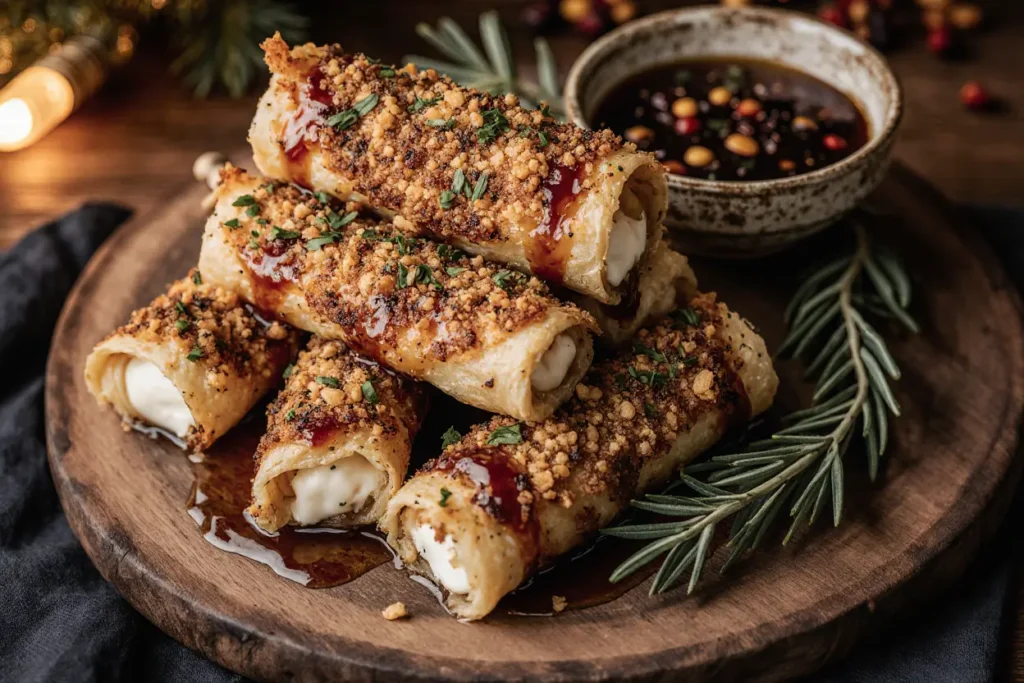
Storing Tips for the Recipe
Pre-Assembly Storage: Phyllo dough keeps in the refrigerator for up to 3 weeks after opening if wrapped tightly in plastic wrap and stored in an airtight container to prevent moisture absorption. Brie stores refrigerated in its original packaging for 1-2 weeks before opening, or 3-5 days after opening when wrapped in wax paper (not plastic, which traps moisture and creates sliminess).
Make-Ahead Strategy: Assemble your wraps completely up to 4 hours before baking, arrange on the parchment-lined baking sheet, cover loosely with plastic wrap, and refrigerate. Do not brush with the final butter layer until just before baking—this prevents sogginess. This make-ahead approach is revolutionary for entertaining, allowing you to simply slide the pan into the oven when guests arrive.
Storing Baked Wraps: While these are best enjoyed fresh, leftover baked wraps can be stored in an airtight container in the refrigerator for up to 2 days. The phyllo will lose its crispness, but you can revive it: place wraps on a baking sheet and reheat at 350°F for 8-10 minutes until crispy again. Don’t microwave—it creates steam that turns phyllo leathery.
Freezing for Future Use: Assembled, unbaked wraps freeze exceptionally well for up to 1 month. Arrange on a parchment-lined baking sheet and freeze until solid (about 2 hours), then transfer to a freezer bag, separating layers with parchment paper. Bake directly from frozen, adding 5-7 minutes to the cooking time. This technique means you can always have an impressive appetizer ready at a moment’s notice.
Honey Drizzle Storage: The spicy honey keeps at room temperature in an airtight container for up to 2 weeks, or refrigerated for up to 1 month. If honey crystallizes (which is natural), gently warm in a water bath to return it to liquid form. Make a double batch—it’s incredible drizzled over pizza, roasted vegetables, or yogurt parfaits.
Ingredient Prep Shortcuts: Cut Brie wedges up to 1 day ahead and store in an airtight container in the refrigerator. Prepare the honey drizzle up to 1 week ahead and store at room temperature, giving it a quick stir before using.
Conclusion
The Crispy Baked Brie Wraps with Spicy Honey Drizzle prove that impressive entertaining doesn’t require culinary school training or hours of labor. In less than 30 minutes, you’ve created a restaurant-quality appetizer that delivers on every level: visual appeal, textural contrast, and flavor complexity that keeps guests reaching for more. The golden phyllo shatters beautifully to reveal luxurious melted cheese, while the spicy honey drizzle adds that unexpected element that elevates this from simple to sensational.
This recipe embodies the modern approach to home cooking—efficient yet elegant, approachable yet impressive. Whether you’re serving these at your next dinner party, holiday gathering, or quiet night in, they demonstrate that the best food comes from thoughtful combinations of quality ingredients rather than complicated techniques.
Ready to experience that satisfying crunch followed by creamy, spicy-sweet perfection? Gather your ingredients, preheat your oven, and prepare to add a new signature appetizer to your entertaining repertoire. After you try these wraps, share your experience in the comments below—did you experiment with different cheeses? Try an alternative honey infusion? We’d love to hear how you made this recipe your own. And if you’re looking for more effortless-yet-elegant appetizers, explore our collection of quick entertaining recipes that’ll make you look like a culinary genius without the stress.
FAQs
Can I use a different cheese instead of Brie? Absolutely! Camembert offers a similar creamy texture with slightly earthier, more mushroom-like notes. For a milder option, try triple-cream cheese varieties. Goat cheese (chèvre) creates a tangier profile that pairs beautifully with the honey. Even mozzarella works, though it’s less complex in flavor. Whatever cheese you choose, ensure it’s full-fat and has a soft, creamy texture that will melt beautifully rather than becoming rubbery.
What if my phyllo dough keeps tearing? Tears happen even to professionals—phyllo is incredibly delicate. The good news: small tears don’t matter since you’re using multiple layers. Simply patch tears with a small piece of phyllo and brush with butter to seal. If sheets are consistently crumbling, they may have dried out too much or been improperly thawed. Ensure you’re keeping unused sheets covered with a damp towel, and work in a humid environment if possible (run the dishwasher or boil water on the stove to add moisture to the air).
How spicy is the honey drizzle? With 1 teaspoon of red pepper flakes, the drizzle has gentle warmth—about 3 out of 10 on the heat scale. You’ll notice a pleasant tingle rather than face-melting spice. Start with ½ teaspoon if you’re heat-sensitive, or increase to 2 teaspoons (or add a pinch of cayenne) if you prefer serious heat. Remember, the sweetness of the honey tempers the spice significantly.
Can I make these vegan? Yes, with some modifications. Use vegan Brie alternatives (made from cashews or coconut oil), vegan butter or olive oil for brushing, and ensure your phyllo is vegan (most brands are, but check labels as some contain butter). The honey drizzle can be replaced with maple syrup or agave nectar infused with the same spices. The texture won’t be identical to traditional Brie, but you’ll still achieve a delicious, crispy wrap with creamy filling.
Why did my cheese leak out during baking? Cheese escape typically results from: (1) cheese being too warm when wrapped, causing early melting; (2) insufficient overlap at seams, creating weak points; (3) oven temperature too high, causing rapid melting before the phyllo sets; or (4) phyllo tears that weren’t patched. Ensure your cheese is cold, wrap tightly with good seam overlap, verify oven temperature with a thermometer, and patch any visible tears before baking.
Can I prepare these the night before? While you can assemble them up to 4 hours ahead and refrigerate, overnight storage isn’t ideal—the phyllo absorbs moisture from the cheese, resulting in soggy wraps. If you must prep further ahead, freeze the assembled wraps instead (see storing tips section). They bake beautifully from frozen, giving you the make-ahead convenience without compromising texture.
What’s the best way to cut Brie into wedges? Use unwaxed dental floss for the cleanest cuts: hold the floss taut, press down through the cheese wheel, and pull ends in opposite directions. This method prevents the cheese from sticking to a knife blade and smashing. Alternatively, use a thin, sharp knife dipped in hot water and wiped dry between cuts. Always cut Brie when it’s cold for the neatest results.
My honey drizzle crystallized—is it still usable? Definitely! Honey crystallization is natural and doesn’t indicate spoilage. Gently warm the container in a bowl of warm (not boiling) water for 10-15 minutes, stirring occasionally, until crystals dissolve. Never microwave honey, as high heat destroys beneficial enzymes and can create hot spots that burn.

